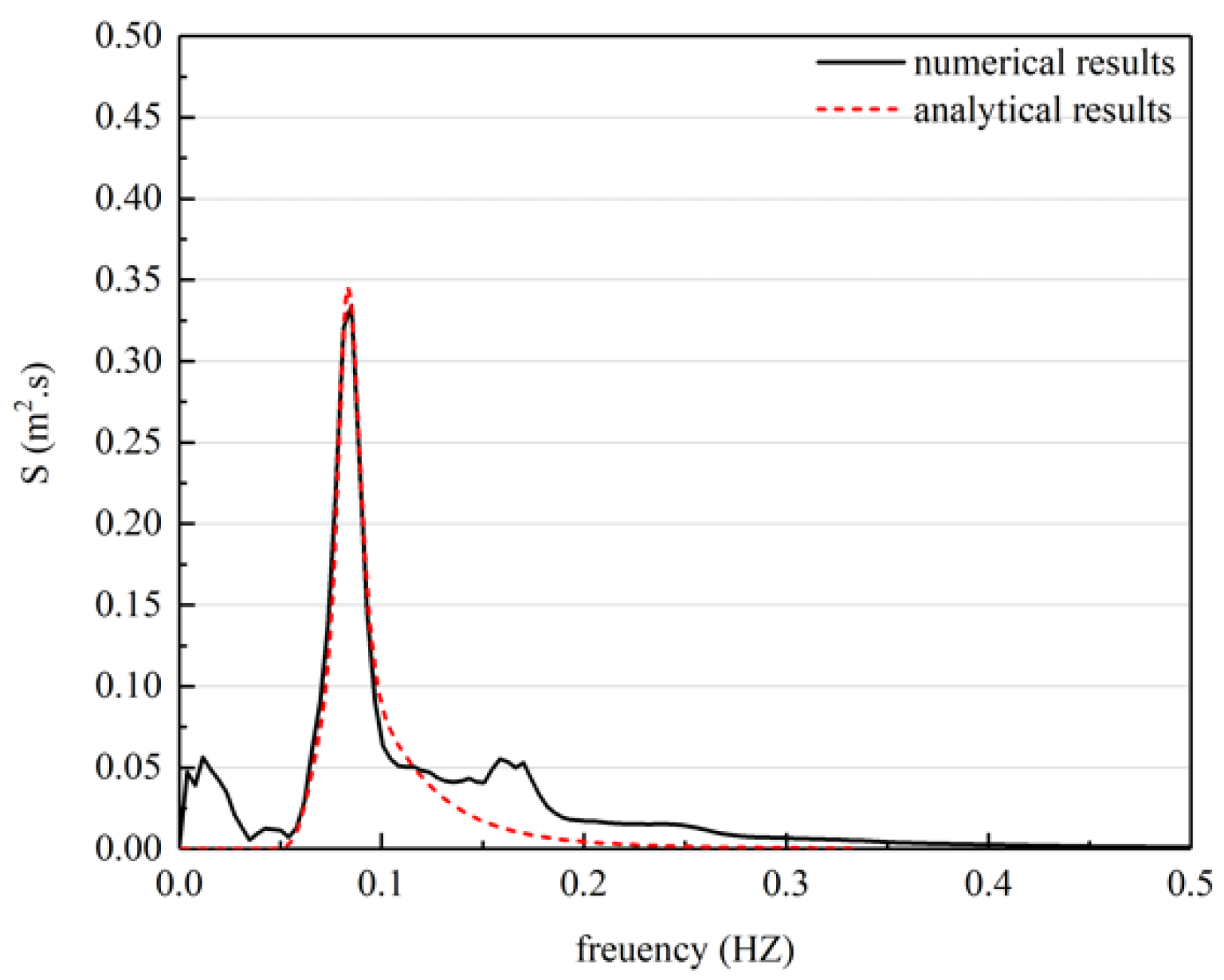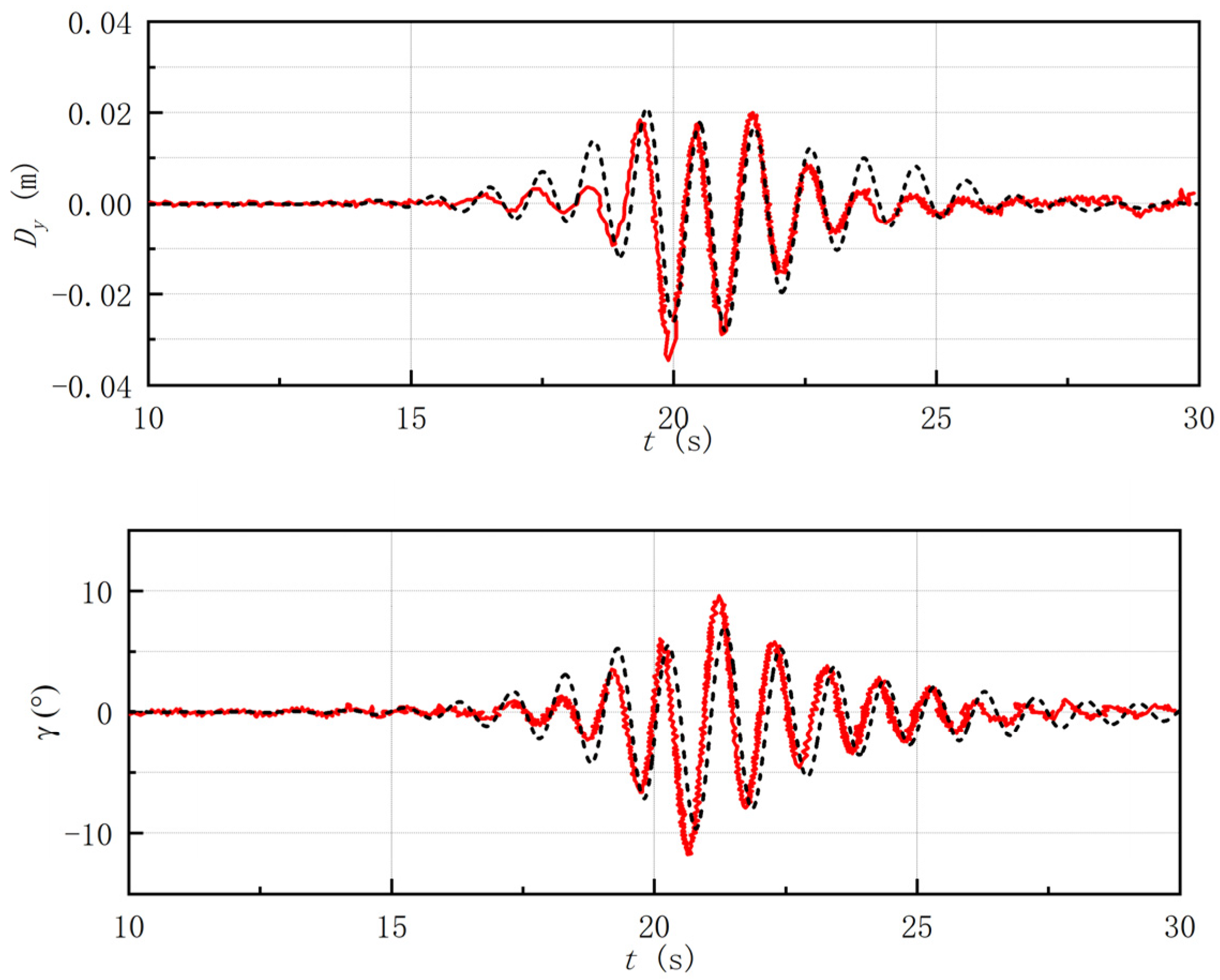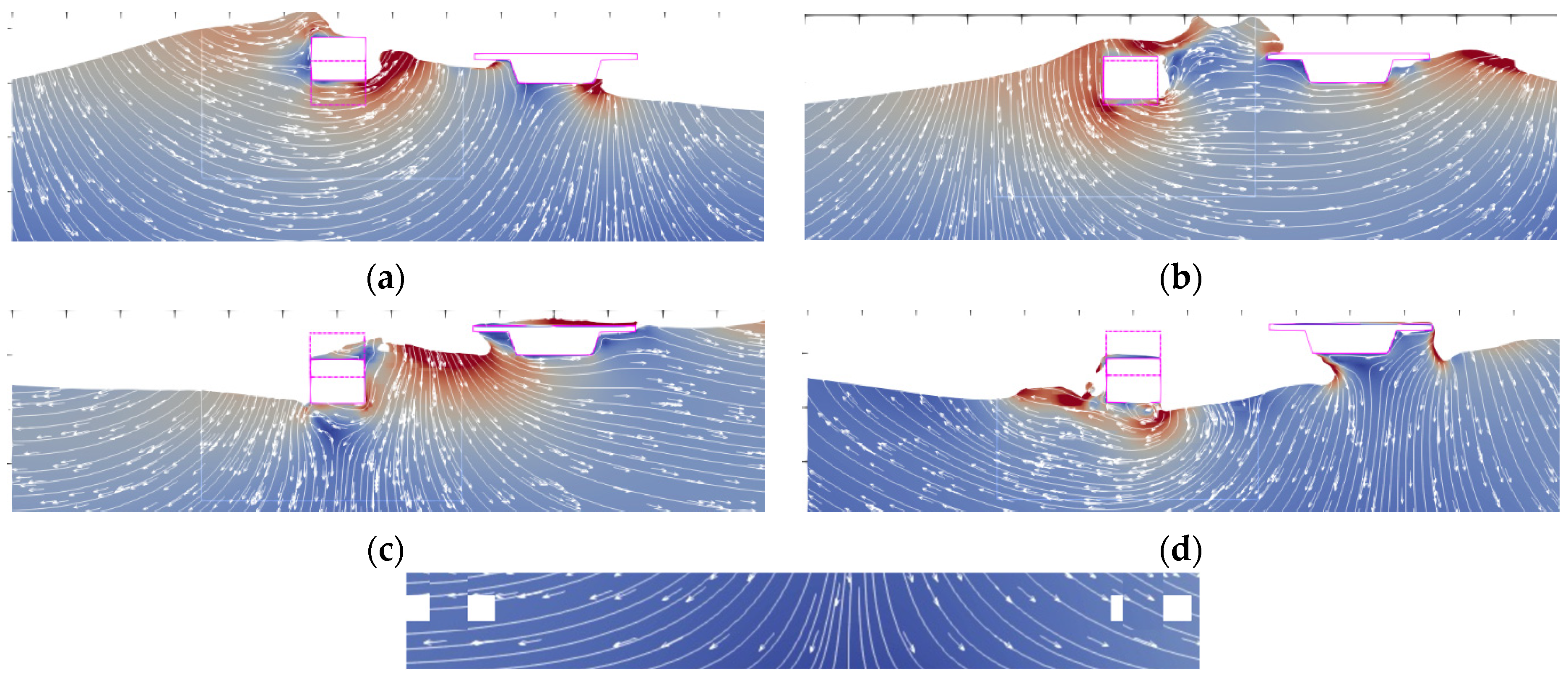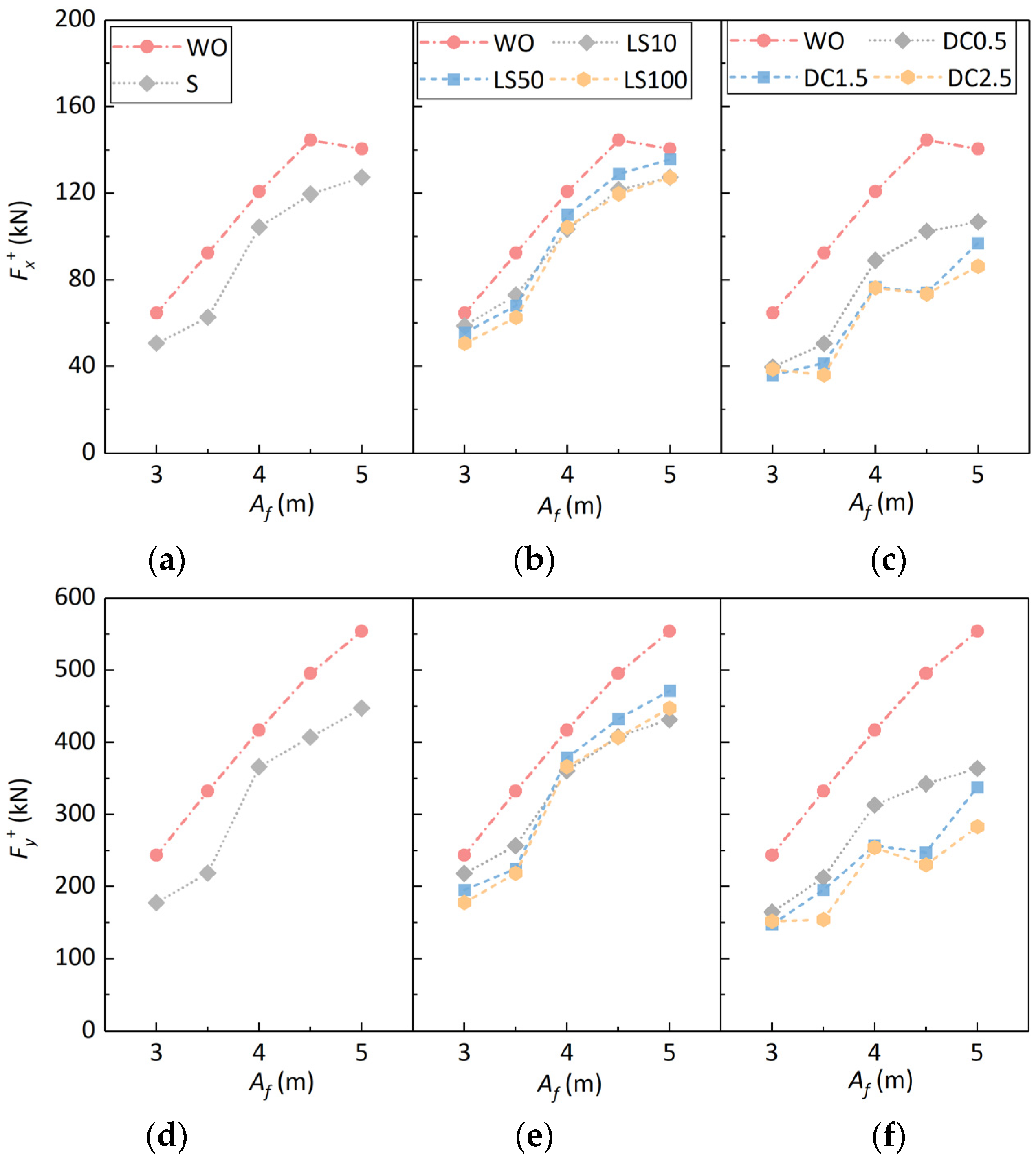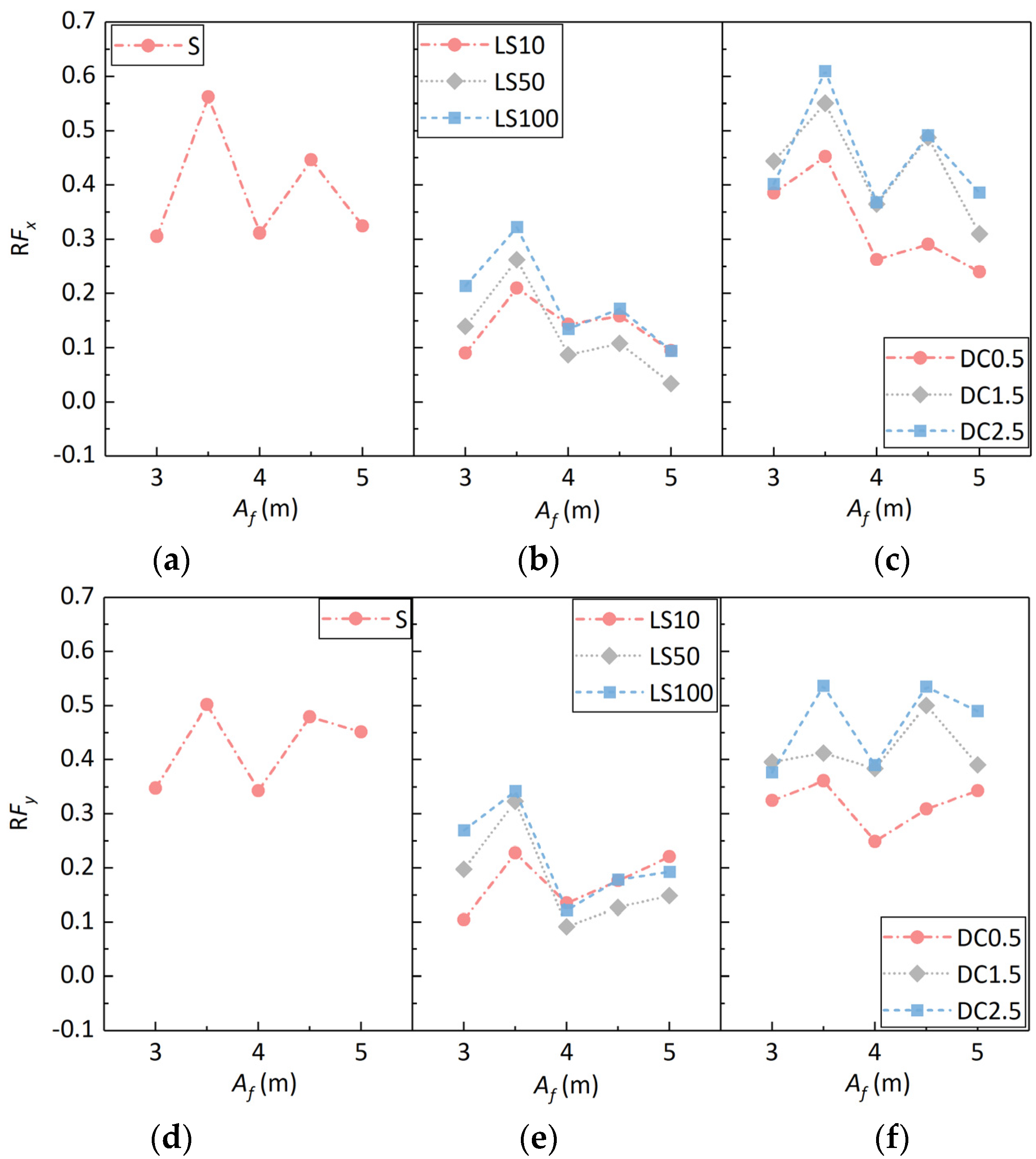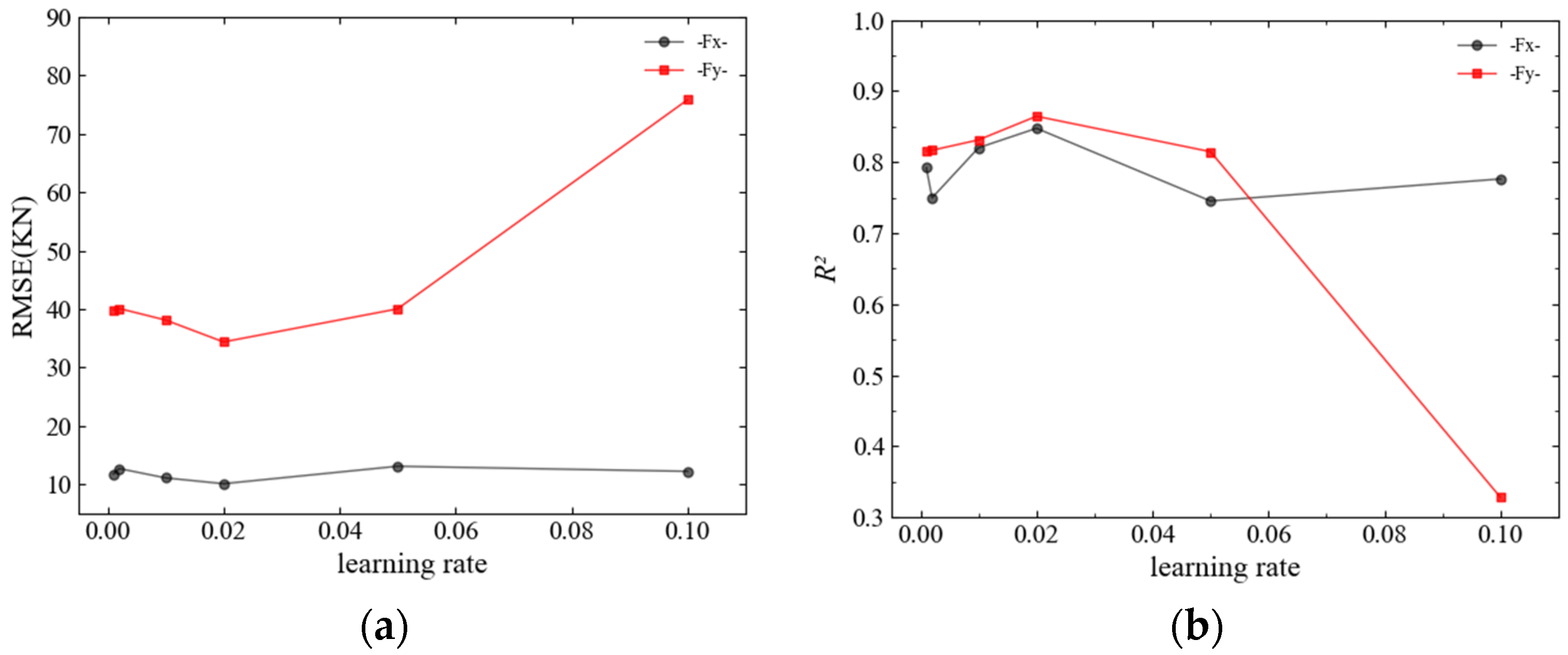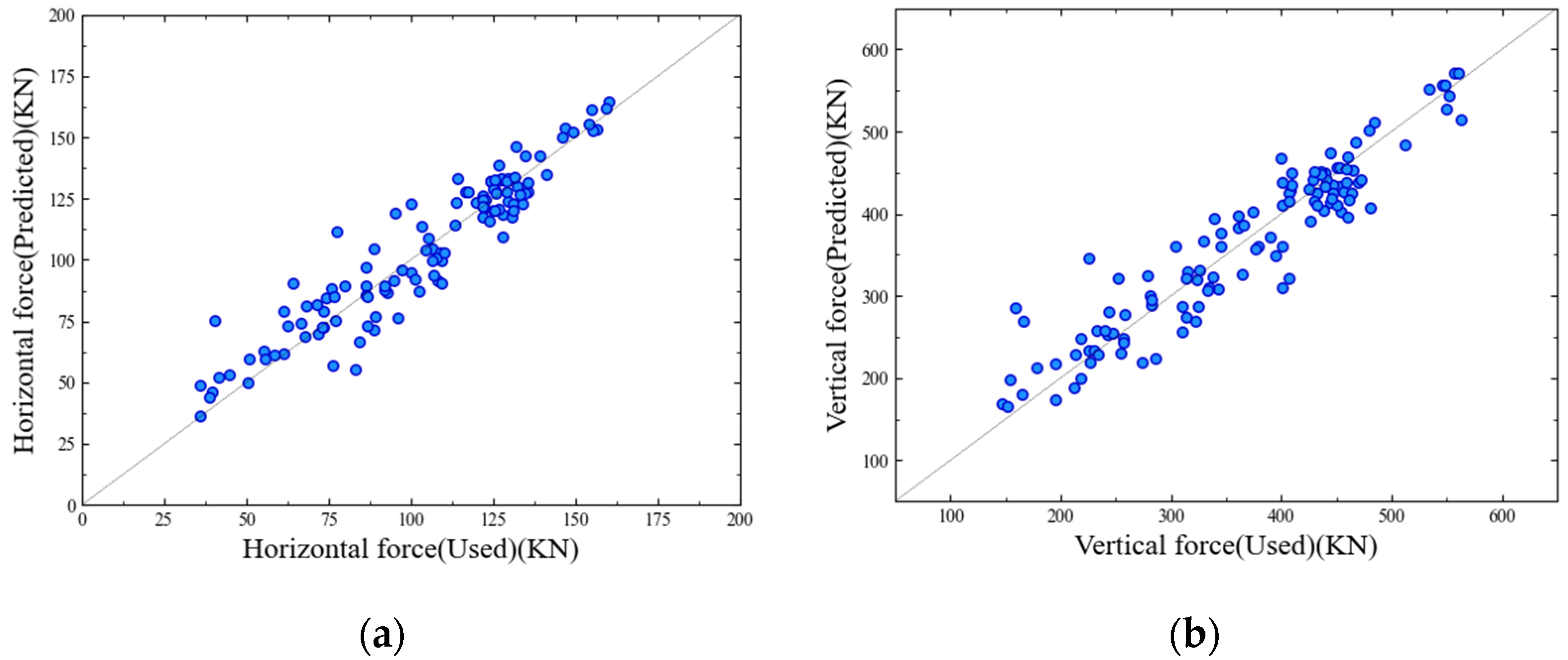4.1. Parametric Study
Three possible vertical motion characteristics of the floating box are considered in the study: (1) The floating box does not generate any motion in the vertical direction, similar to the pier breakwater. In this case, the solidification mode is used to constrain the motion of the floating box in the numerical model. (2) The floating box shows a sinking motion in the vertical direction, but its motion is constrained. In this case, a spring restraint is used in the numerical model, and three restraint stiffnesses k = 10 kN/m, 50 kN/m and 100 kN/m are considered. (3) Considering that the displacement of the floating box is generally limited to a certain range in practical engineering, the third case, i.e., the limit restraint, is considered. In this case, when the displacement of the floating tank is within the displacement limit, the floating tank can freely sink and float, while when the displacement of the floating tank exceeds the displacement limit, a spring restraint with high rigidity is applied to the floating tank to restrain its movement. For convenience of description, the first type of breakwater is referred to as fixed breakwater, denoted by “S”, and the second type of breakwater is referred to as elastically restrained breakwater, denoted by “LS”, where “LS10”, “LS50” and “LS100” represent three groups of restraint stiffness k = 10 kN/m, 50 kN/m and 100 kN/m, respectively, and the third type of breakwater is referred to as displacement restrained breakwater, denoted by “DC”, where “DC0.5”, “DC1.5” and “DC2.5” represent three groups of displacement limits of ±0.5 m, ±1.5 m and ±2.5 m, respectively. The density of the floating tank is ρf = 500 kg/m3. When the waves are not acting, the floating breakwater is in a semi-submerged state and its center of mass is flush with the hydrostatic water surface.
The basic parameters of the numerical flume are set as follows: the wave flume is 1350 m long, 54 m high and 1 m wide, and the center of the box-girder superstructure is located at
x = 800 m (as shown in
Figure 5a). The wave-absorbing zone is set in the range of
x = 0–200 m after the inlet boundary of the numerical flume, and
x = 1000~1350 m before the output boundary. The numerical flume is bounded by inlet and pressure outlet boundaries on its left and right sides, respectively. Its structure surface serves as a wall boundary, while the bottom of the flume acts as a slip boundary. An empty condition is applied to the front–back boundary, whereas an atmospheric boundary condition governs the top of the numerical wave flume. Considering that the box-girder superstructure is submerged, the bottom surface is exactly flush with the water surface, and the bottom of the box-girder superstructure is
Z = 30 m from the bottom of the wave flume. The cross-sectional dimensions of the box-girder superstructure are
B = 15 m for the width of the deck,
D = 2.7 m for the height of the girder,
Bg = 7 m for the width of the bottom girder, and
Dd = 0.6 m for the thickness of the deck. The distance between the center of the floating breakwater and the leading edge of the box-girder superstructure is
Lf, and the width of the floating breakwater is
Bf while the height is
Hf.
The meshes were generated through the development of structured background meshes, which underwent refinement in the primary computational domain and further refinement near the girder model. A red nested mobile mesh was utilized at the breakwater location to monitor the movement of the floating breakwater. In the main computational domain, a range of mesh sizes were employed to assess mesh sensitivity.
Figure 5c illustrates the variation in the maximum horizontal wave forces across different mesh sizes (indicated by total grid count) for a case with wave amplitude
Af = 4 m. It is evident that with a total of 6.2 × 10
6 grids, the numerical computation can be executed precisely and efficiently. After conducting a grid independence test, the optimal mesh size was determined as follows: A horizontal mesh size of 0.4 m was used in the near-inlet boundary zone, while a smaller mesh size of 0.1 m was employed in the main computational domain and an even finer mesh size of 0.03 m was utilized in the near-outlet boundary zone. In addition, vertical spatial distances of 0.4 m were applied to the atmosphere boundary region, whereas air–water interfaces and deeper water regions required more refined spacing, with values of 0.1 m and 0.03 m, respectively.
Considering five groups of wave amplitude Af = 3 m~5 m, the wave reduction performance of three types of floating breakwaters under the action of focused waves with different amplitudes is analyzed, keeping the structural parameters of the breakwater unchanged, the height of the floating breakwater Hf = 4 m, the width of the floating breakwater Bf = 5 m, and the distance between the floating box and the box-girder superstructure Lf = 10 m.
The time histories of wave forces on the box-girder superstructure (only the moment during the maximum focused wave action is given) are shown in
Figure 6a–c for the cases with fixed, elastically restrained, and displacement-restricted breakwaters, respectively, where the maximum focused wave amplitude
Af = 5 m. For comparison, the time histories of wave forces on the box-girder superstructure without the floating breakwater are also given (represented by “WO”). Comparing the cases with and without breakwaters, the installation of the floating breakwater does not significantly change the time history characteristics of wave forces on the box-girder superstructure, but exhibits the following characteristics:
- (1)
There is an obvious phase difference between the peak wave force in the slamming phase and the peak wave force without breakwaters, and this phase difference varies under the influence of different types of breakwaters. For fixed breakwaters, the phase difference is significant. For elastically restrained breakwaters, the phase difference increases with increasing restraint stiffness. For the displacement-restricted breakwater, the phase difference increases with decreasing displacement limit. This is due to the fact that when the displacement amplitude of the floating box is small, the wave surface on the back of the breakwater rises rapidly due to the wave bypassing from below the breakwater, so the wave and the box-girder superstructure act in advance, and the phase difference increases;
- (2)
The peak value of the slamming wave force decreases, especially under the influence of the fixed and displacement-restricted breakwater, and for the conditions shown in
Figure 6, the maximum decrease can reach 49.0%. This indicates that the presence of fixed and displacement-restricted breakwaters weakens the slamming force on the box-girder superstructure;
- (3)
The wave force on the box-girder superstructure in the climbing phase is slightly reduced, and the change curve of the vertical wave force shows a smoother shape, which also indicates that the slamming force component is weakened.
The displacement responses of the elastically constrained and displacement-constrained floating breakwater in
Figure 6b,c are shown in
Figure 7. As can be seen from the figure, although the elastically constrained floating breakwater has the same or an even larger displacement amplitude comparable to that of the constrained float box (e.g., the positive amplitude of the floating breakwater in the LS10 condition is comparable to that in the DC2.5 condition), its reduction effect on the wave force of the box-girder superstructure is weaker (see
Figure 6b), which means that the wave reduction performance of the floating breakwater does not depend only on its floating amplitude, but also on its motion type.
In order to further investigate the influence of breakwater motion characteristics on the wave force of the box-girder superstructure, the flow field diagrams at the characteristic moments after the installation of the fixed breakwater (S), elastic restrained breakwater (LS50), and the displacement-restricted breakwater (DC2.5) are shown in
Figure 8,
Figure 9 and
Figure 10, respectively. Compared to the flow field distribution around the box-girder superstructure without a breakwater, the presence of the floating breakwater significantly changes the flow field distribution on the waveward side of the box-girder superstructure.
For the fixed breakwater, when the wave propagates to the position of the floating breakwater, a part of the wave runs up to the top of the floating breakwater, while a part of the wave forms a bypass flow along the bottom of the floating breakwater. Due to the wave bypass, the wave surface on the waveward side of the box-girder superstructure rises rapidly, and the wave surface submerges the bottom of the box-girder superstructure and the web on the waveward side, while the horizontal and vertical forces reach the maximum (
Figure 8b). Compared with the flow field diagram at the same moment without the breakwater, the existence of the breakwater significantly weakens the wave energy between the wave crest and the box-girder superstructure on the wave side, and on the other hand, due to the wave bypass flow, the wave surface between the breakwater and the box-girder superstructure is significantly changed, and the liquid surface under the flange on the wave side is depressed, while the gas under the flange escapes. Under the combined influence of the above two factors, the wave force of the box-girder superstructure during the slamming stage is greatly reduced. As the wave continues to propagate, the wave at the top of the floating breakwater intersects with the wave bypassing below, and the interaction of these two parts of the wave causes the wave energy in the region to increase. Then, the wave hits the top deck of the box-girder superstructure. Compared with the case without wave protection, the wave surface morphology of the wave run-up on the top deck of the box-girder superstructure is significantly different.
The elastically and displacement-restrained breakwaters have similar effects on the flow field around the box-girder superstructure as the fixed breakwater. The presence of the breakwater significantly weakens the wave energy between the wave crest and the waveward side of the box-girder superstructure, and on the other hand, the wave surface between the breakwater and the box-girder superstructure is significantly modified due to wave bypassing and reflection. However, there are also differences between the flow fields due to the different motion characteristics of the breakwater. As in
Figure 9a, the elastic restrained breakwater floats up, the water level on the waveward side of the box-girder superstructure increases, and the gas is trapped between the water and the flange on the waveward side, so the reduction effect of the elastic restrained breakwater on the wave force of the box-girder superstructure during the slamming stage is weak. For the displacement-restrained breakwater (e.g.,
Figure 10a), the floating breakwater floats up to cause a significant increase in the wake bypass fluid energy, while the wake bypass flow line of the floating breakwater is also different from that of the fixed and elastic restrained breakwater. Nevertheless, the wave force is significantly reduced in the slamming stage under the influence of the displacement-restrained breakwater due to the reduction in the wave surface below the flanking edge on the waveward side of the box-girder superstructure. As the floating breakwater gradually sinks to near the initial position, a large amount of gas is trapped at the rear of the displacement-restrained breakwater. As the floating tank continues to sink, the fluid flow and energy distribution around the breakwater are affected by the motion characteristics of the breakwater, showing significant differences, but due to the lowering of the water level, the impact on the flow field around the box-girder superstructure is smaller, so the impact on the wave force on the box-girder superstructure is smaller.
To further analyze the wave reduction effects of various types of breakwaters, a comparison of the maximum horizontal (
Fx+) and vertical wave force (
Fy+) on the box-girder superstructure with and without the breakwater under different wave amplitudes is given in
Figure 11. Additionally, the maximum horizontal (
Fx+) and vertical wave force (
Fy+) in this study represent the peak values of the time history of wave forces acting on the box-girder superstructure under a specific wave case. Compared with the case without a breakwater, both the maximum horizontal force and the maximum vertical force on the box-girder superstructure are reduced after the breakwater is installed. However, the influence of the breakwater on the wave force of the box-girder superstructure varies for different motion characteristics of the floating breakwater. For this reason, the reduction rates of the maximum horizontal force and maximum vertical force (
RFx and
RFy) of the box-girder superstructure after installing breakwaters with different wave amplitudes are given in
Figure 12a,b, respectively. A very interesting phenomenon is noted here; that is, with the increase in the wave amplitude, the horizontal wave force on the box girder does not increase linearly, but decreases after the wave amplitude reaches 4.5 m (as shown in
Figure 11a). The elevated state of the box-girder superstructure may account for this phenomenon. When the wave amplitude falls within a certain range, the majority of waves exert force on the web of the box-girder superstructure, leading to an increase in horizontal wave forces. However, with the continuous increase in waves, an excessive wave amplitude leads to excessive wave run-ups when most of the waves interact with the box-girder superstructure, which consumes the energy of the wave action. On the contrary, the horizontal wave force on the box-girder superstructure is reduced.
The fixed breakwater, elastic restrained breakwater and displacement-restrained breakwater are all beneficial in reducing the maximum horizontal and vertical forces of the main beam, but there is no clear relationship between the reduction rate and the wave amplitude of the focused waves. For the fixed breakwater, the maximum reduction rate of wave force on the box girder superstructure was reached at the wave amplitude Af = 3.5 m. The reduction rates of horizontal force and vertical force reached 56.2% and 50.2%, respectively.
For the elastic restrained breakwater, the reduction rate reached its maximum at wave amplitude Af = 3.5 m. In addition, the restraint stiffness of the floating box also affected the reduction rate. For wave amplitude Af < 4 m, the larger the confinement stiffness, the larger the reduction rate, while for Af ≥ 4 m, the reduction rate of the wave force is similar for stiffness values of k = 10 kN/m and k = 100 kN/m, while the reduction rate of the wave force applied to the box-girder superstructure is small for k = 50 kN/m (e.g., Af = 5 m, RFx = 3.3%), which has almost no effect on the wave force on the box-girder superstructure.
Similar to the effects of fixed and elastic restrained breakwaters, the reduction rate of the horizontal force RFx also reached the maximum at Af = 3.5 m after the installation of the displacement restrained breakwater, and the maximum reduction rate reached 61.0%, which is better than that of the fixed breakwater. The reduction rate of the vertical force was affected by the displacement limit, and the reduction rate of the vertical force showed different trends with changes in wave amplitude for different displacement limits. For cases DC0.5 and DC2.5, the reduction rate of the vertical force reaches its maximum at Af = 3.5 m with RFy = 36.1% and 53.6%, respectively, while for DC1.5, the reduction rate of the vertical force reaches the maximum at Af = 3.5 m with RFy = 50.1%. When comparing the cases with different displacement limits, it can be found that the effect of displacement limits is smaller when the wave amplitude is small (Af = 3.0 m), and when the wave amplitude is larger than 3.0 m, the reduction effect of wave force is weaker for the case DC0.5, while the reduction effect of wave force is better for the cases of DC1.5 and DC2.5, and the larger the displacement limit is, the more obvious the reduction effect of wave force is at Af = 5.0 m. It can be observed that the weakening of wave force on the box-girder superstructure induced by the floating breakwater is not directly proportional to the amplitudes of waves. Generally, the most effective reduction in force is achieved when wave amplitudes are around 3.5 m. As the wave amplitude continues to increase, the interaction between the waves passing over the floating breakwater and the waves between the floating breakwater and the box-girder superstructure may lead to an increase in the speed of the water particles acting on the box-girder superstructure, thereby augmenting the wave forces exerted on the box-girder superstructure.
In the test region of this study, the reduction rate of horizontal force for fixed breakwaters reached 30.5~56.2%, and the reduction rate of vertical force reached 34.3~50.2%. The reduction rate of horizontal force for elastic restrained breakwaters ranged from 3.3% to approximately 32.2%, and the reduction rate of vertical force ranged from 9.1% to about 34.2%. The reduction rate of horizontal force for displacement-restricted breakwaters reached 24.0~61.0% and the reduction rate of vertical force was 24.9~53.6%. In general, the wave reduction performances of the displacement-restricted breakwater and the fixed breakwater were better, and the displacement-restricted breakwater with a displacement limit of 2.5 m had the best effect, being able to significantly reduce the horizontal and vertical forces on the box-girder superstructure.
4.2. Prediction Model
The number of samples used in the prediction model was 119. The maximum wave amplitude in the samples ranged from
Af = 3 m to 5 m, the breakwater width ranged from
B = 5 m to 25 m, the breakwater height ranged from
H = 2 m to 10 m, the constrained stiffness ranged from
k = 0 kN/m to 106 kN/m, et al. The range values of the relevant parameter are shown in
Table 1. The model used 10-fold cross-validation to divide the sample dataset into 10 subsets. The model was trained and tested using 10 training sets/test sets, and the average of the 10 test errors was returned as the basis for the model evaluation. It is worth noting that out of the 10 datasets, 7 were designated as training sets, while the remaining 3 served as test sets.
Since the breakwater constraint in the test includes three types of motion—fixed, elastic constraint, and displacement constraint—the constraint stiffness (k) and displacement constraint (S) are included in the input parameters of the BP model to distinguish the different types of motion. The BP neural network model outputs the maximum horizontal and vertical forces, with input parameters including the maximum wave amplitude Af, breakwater width B, breakwater height H, breakwater spacing L, constraint stiffness k, and constraint displacement S.
There are many parameters involved in the BP neural network structure (such as batch size, learning rate, optimizer, activation function, number of structural layers, and number of neurons in the hidden layer), and the number of structural layers is two due to the selection of double hidden layers for this prediction. Different parameter configurations will have different training effects, so it is necessary to debug and compare and filter the parameters in the model in order to finally find a better solution through parameter tuning.
The optimization strategies used in the parameter debugging of the constructed horizontal and vertical force prediction model are as follows: (1) Based on the model network structure, the candidate values of the hyperparameters are given, and the candidate parameters used in this model are shown in
Table 2. (2) The initial values of each hyperparameter are set as follows—the batch size is 30, the training period is 1000, the learning rate is 0.02, the activation function is relu, a double hidden layer network is used, and the number of neurons in both hidden layer 1 and hidden layer 2 is set to 40. (3) The parameters are optimized and updated in order according to the parameter order given in
Table 2. When one parameter is optimized, the other parameters are fixed (where the other parameters are updated to the optimization result if they have been optimized and debugged, and the initial values are used if they have not been optimized and debugged). Then the current parameter candidates are traversed, the learning model is trained, and the better value of the current parameter is determined by model selection. The current parameter optimization results are taken into account in the optimization process of the next parameter until the optimization of all parameters in
Table 2 is completed. (4) The parameter optimization is performed for several rounds by repeating step 3 to obtain a better parameter configuration. The model constructed in this section performs three rounds of hyperparameter optimization.
Taking the optimization process of each parameter in the first round as an example, the BP neural network is based on the gradient descent update strategy, and the batch size indicates the number of samples supplied to the program for training at each step. In this study, the small batch gradient method is used to determine alternative batch size candidates based on the number of training samples: 10, 20, 30, 40, 80, and 200. In the batch size selection, the other parameters are fixed and the initial values are used. The RMSEs of horizontal and vertical forces at different batch sizes and the Goodness of Fit
R2 values are shown in
Figure 13, which shows that as the batch size increases, the RMSEs of horizontal and vertical forces show first a decreasing and then an increasing trend, reaching the minimum value at the batch size of 40. The
R2 values of horizontal force and vertical force are 0.83017 and 0.84240, respectively, under the current parameter configuration, and the hyperparameters of horizontal force and vertical force are updated to continue the hyperparameter optimization.
The BP neural network updates parameters based on the gradient descent method by setting the learning rate to control the size of the network weights updated at each iteration. The learning rate is between 0 and 1. A smaller learning rate can make the network converge more stably and accurately, but it will reduce the training speed; a larger learning rate can speed up the training speed of the network, but it may lead to unstable training or failure to converge. Therefore, it is necessary to choose the appropriate learning rate for neural network learning. The study takes the same value of learning rate for each layer of the network weight threshold update, and chooses the candidate values of 0.001, 0.002, 0.01, 0.02, 0.05 and 0.1 for learning rate debugging.
The RMSE and
R2 values of the horizontal and vertical wave forces at different learning rates are shown in
Figure 14. As can be seen from the figure, when the learning rate increases from 0.001 to 0.02, the RMSE for maximum vertical forces gradually decreases with the increasing learning rate. The horizontal force RMSE changes very little, and the minimum value is obtained when the learning rate is 0.02. When the learning rate is set as 0.02, the
R2 of the horizontal force and the vertical force are 0.84749 and 0.86444, respectively.
The same method is used to determine the optimal values of parameters such as training time, activation function, and number of hidden neurons in the first and second layers. The second and third rounds of hyperparameter optimization are repeated, and finally the optimal configuration of hyperparameters for the horizontal force prediction model is determined to be batch size 40, training period 800, learning rate 0.02, activation function relu, number of neurons in both the first and second hidden layers 40, and final
R2 0.8474; the configuration of hyperparameters for the vertical force prediction model is set as batch size 40, training period 1400, learning rate 0.02, activation function relu, number of neurons in both the first and second hidden layers 40, and final
R2 0.8644. The comparison between the prediction results and the actual numerical simulation results is given in
Figure 15. The prediction model constructed by the BP neural network in this study agrees well with the numerical calculation results, with high accuracy.

